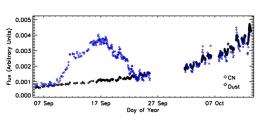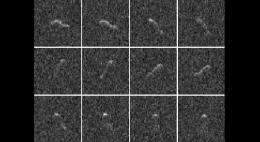Cometary poison gas geyser heralds surprises

As NASA's Deep Impact (EPOXI) probe approaches Comet Hartley 2 for a close encounter on Nov. 4th, mission scientists are certain of only one thing:
"We're about to be surprised," says principal investigator Mike A'Hearn of the University of Maryland. "This comet is unlike any we've visited before, and we don't know what we're going to find."
In recent years, international spacecraft have buzzed the cores of four comets: Halley, Tempel 1, Borrelly and Wild 2. Deep Impact even blew a hole in one of them (Tempel 1) to see what was beneath the surface. Those previous flybys, however, may not have prepared researchers for the comet at hand.
"Comet Hartley 2 is smaller yet much more active than the others," explains A'Hearn. "Although its core is only 2 km wide—about a third the size of Tempel 1—it is spewing five times more gas and dust."
The comet has already shocked the science team by producing a massive surge of CN, the cyanogen radical commonly known as "cyanide." Cyanide itself wasn't the surprise; CN is a common ingredient of comet cores. Rather, it was the size and purity of the outburst that has researchers puzzled.
"The abundance of CN in the comet's atmosphere jumped by a factor of five over an eight day period in September—that's huge," says A'Hearn. "Curiously, however, there was no corresponding increase in dust."

This flies in the face of conventional wisdom. Comet cores are thought to be a mish-mash of volatile ices, rock, and dust particles, generally well mixed. When the ice evaporates to produce a jet of gas, dust naturally comes along for the ride. Yet this outburst was pure gas.
"We have never seen this kind of activity in a comet before. The amount of gas suggests a global event—but how could such an event occur without dust? It's a mystery."
A'Hearn stresses that readers shouldn't worry about a "poisonous comet." For one thing, Comet Hartley 2 is more than 11 million miles from Earth. There's no direct contact between our planet and the comet's gaseous shroud. Furthermore, the cyanide gas is very diffuse. If it did touch Earth, it would not be able to penetrate our planet's dense atmosphere.
May of 1910 provides a relevant example: Astronomers had just announced that Earth was passing through the cyanide-containing tail of Comet Halley, triggering a minor panic. People walked the streets of New York wearing gas masks, and unscrupulous merchants made a pretty penny selling "comet pills" to counteract poisoning. Nothing happened. Even direct contact with Halley’s tail produced no ill effects.
The real significance of Hartley 2's cyanide surge is the tease. Something mysterious is happening … and we're about to find out what.
The flyby officially begins on the evening of Nov. 3rd when Deep Impact/EPOXI is about 18 hours from closest approach. During the early stages of the encounter, all of the close-up images will be stored onboard the spacecraft. This is because Deep Impact cannot simultaneously point its high gain antenna toward Earth and its imagers toward the comet.
Closest approach occurs around 10 am EDT on Nov.4th at a distance of 435 miles. About a half an hour later, the changing geometry of the encounter will allow simultaneous communications and imaging. With its big antenna once again pointing toward Earth, Deep Impact/EPOXI will begin transmitting close-up pictures of Comet Hartley 2. The complete data dump will take several hours.
"We will be waiting," said A'Hearn. "The best images won't reach Earth until many hours after the actual encounter."
Data from the close approach will continue to download through the 6th of November, but NASA will release preliminary results sooner than that. A live press conference is scheduled for 4 pm EDT (1 pm PDT) on Nov. 4th.
More information: epoxi.umd.edu/
Provided by JPL/NASA





















